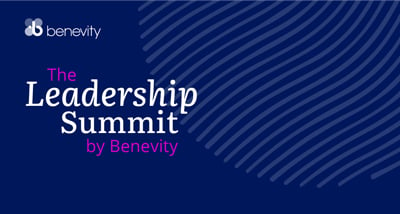March 9, 2021
Insights from Benevity’s Invitation-Only Corporate Purpose Leadership Summit
The biggest insight coming out of this year’s Summit is that 2021 is the Year of “S” when it comes to ESG (Environment, Social, Governance). This is prompting corporate purpose professionals to level up their practice and measurement in this area.
This year’s Summit, held on March 1st, saw almost 25 executives from some of the world’s most purpose-driven brands including Nike, Microsoft, UnitedHealth Group, Pfizer, Apple, Prudential, Accenture, Visa and RBC (among others) in a virtual room for a full day. This diverse group provided a glimpse into what’s on the minds of some of the most influential corporate purpose leaders at this pivotal time.
Here’s what we heard:
 2021 is the Year of “S”: According to presenters from McKinsey, CEOs are spending 50% of their time on ESG topics. As a result, purpose professionals are rapidly increasing their literacy and sophistication in this area. While the high ground for the “E” may already have been claimed, top spot for the “S” is still up for grabs, so it'll be up to the progressive and bold brands who are authentically committing to Social to define the playbook. Over time, this will lead to more companies adopting best practices. There was clear recognition that we need to advance how we approach and measure the “S,” as it's not as well defined or as mature as the science-backed measurements of the “E” category. The other thing that became apparent is that the “S” category spans a wide range of stakeholders all the way from frontline workers to board members and requires new ways to better measure well-worn KPIs like employee engagement. This is also where impact needs to be considered in the context of the company, the individual participants and societally–-the essence of stakeholder capitalism.
2021 is the Year of “S”: According to presenters from McKinsey, CEOs are spending 50% of their time on ESG topics. As a result, purpose professionals are rapidly increasing their literacy and sophistication in this area. While the high ground for the “E” may already have been claimed, top spot for the “S” is still up for grabs, so it'll be up to the progressive and bold brands who are authentically committing to Social to define the playbook. Over time, this will lead to more companies adopting best practices. There was clear recognition that we need to advance how we approach and measure the “S,” as it's not as well defined or as mature as the science-backed measurements of the “E” category. The other thing that became apparent is that the “S” category spans a wide range of stakeholders all the way from frontline workers to board members and requires new ways to better measure well-worn KPIs like employee engagement. This is also where impact needs to be considered in the context of the company, the individual participants and societally–-the essence of stakeholder capitalism.
Our friends at McKinsey also noted that many companies are underrated on the “S” because they don't have good measurement mechanisms. This will heighten investment not just in measurement frameworks and approaches, but the strategy, tools and software to deliver them. With all this much-needed emphasis on the “S” flowing from the pandemic and a broader acknowledgement of systemic racism and inequity, ESG is evolving from being a risk mitigation and sustainability tool to a value creation framework that will provide both the impetus and the practices to becoming a truly purpose-driven business.
Purpose is fast becoming a business imperative: As one of the corporate leaders said “running purpose programs these days is the equivalent of being the most popular person in high school.” Corporate Social Responsibility (CSR) leaders are seeing their roles expand across the organization and are becoming more deeply embedded in the company’s strategic goals. But they are also being asked by senior executives what they are doing to respond to the myriad crises we find ourselves in. For example, many leaders were tasked to run special matching campaigns or virtual volunteering events immediately after the COVID pandemic struck and after the murder of George Floyd. These “flash” matching campaigns are becoming a part of the purpose playbook with our data showing 84% of companies ran special matching campaigns above and beyond standard matching programs in 2020. Our data also shows that it resulted in 51% more people donating, and of those who did, it increased their personal contributions by 41%.
Because of the heightened demand on this traditionally under-resourced function, CSR leaders are stretched while needing to up-level the whole company's understanding of what they do, why it’s important and how to do it effectively—both in the short- and longer term. And then they need to scale the knowledge and tools to achieve desired impacts. There were light bulb moments as these leaders realized just how expansive their role has become during this time, cementing that we have moved from CSR to purpose, and it’s not just a change in terminology, but a substantive change in approach.
 Data-driven purpose is on the rise: As purpose takes centre stage with profit, CEOs and Boards of Directors are asking companies with deep investments in purpose, and those proposing them, to rationalize their investments to the same degree that they would rationalize product lines. This is going to require more companies to better integrate their systems and demographic data to be able to clearly articulate the “business case” for purpose with internal metrics, alongside all of the industry stats that prove the value. We are seeing more and more companies invest in the analysis of their programs, looking at how it affects engagement, retention, promotion, diversity, absenteeism, repeat giving behaviour, product usage and brand affinity.
Data-driven purpose is on the rise: As purpose takes centre stage with profit, CEOs and Boards of Directors are asking companies with deep investments in purpose, and those proposing them, to rationalize their investments to the same degree that they would rationalize product lines. This is going to require more companies to better integrate their systems and demographic data to be able to clearly articulate the “business case” for purpose with internal metrics, alongside all of the industry stats that prove the value. We are seeing more and more companies invest in the analysis of their programs, looking at how it affects engagement, retention, promotion, diversity, absenteeism, repeat giving behaviour, product usage and brand affinity.
A virtual world demands a digital-first strategy and a heavy dose of creativity: The most progressive companies are thinking about the shift to virtual not just as an adaptation from physical volunteering to virtual volunteering, but a shift from traditional to digital. They are taking their cues on what “counts” as doing good from their people and expanding their definitions to match those of their employees and customers who see learning, acts of kindness, and taking action as ways to engage in society positively. For example, watching documentaries on topics like racial equity or climate change, reading books on privilege, or advocating on social media or other platforms is now counted as participation in these trailblazing companies. This is a far cry from the more traditional approaches to workplace giving programs that have maintained high thresholds for counting and rewarding participation (like those programs that have minimum donation amounts or only reward employees with a volunteer grant after giving 50 hours of time).
Further, in this WFH world, reaching and engaging people, and connecting them to the culture of the company and their colleagues, presents unique challenges beyond what already exists. To the extent we are looking at a more distributed and remote workforce as a lasting effect of the pandemic, this will require even more creativity in executing on unifying elements and initiatives; corporate and individual purpose will become an even more important lever. Striving for this level of engagement requires (among other things) an integrated digital marketing strategy that leverages data and systems to identify the right audience with the right offer. For example, some companies are using digital technologies to reach out to non-engaged employees with charitable donation currency, recognizing that getting them engaged once will result in future pro-social behaviour.
And of course, even though it’s not just about virtual volunteering, it’s still one of the hottest topics and conundrums everyone is trying to solve. It’s clear corporate purpose executives are committed to seeking new ways to drive volunteer engagement given its well-documented benefits for communities and the sense of well-being, self-efficacy and professional development that people derive from it.
And perhaps somewhat ironically, a discussion led by Dr. Jonathan Zimmerman of University of Pennsylvania revealed the challenges of the virtual context in driving a visceral sense of shared understanding, connection and learning, especially as “My Employer” remains the most trusted source of information, according to the Edelman Trust Barometer. Companies who embrace this broader mandate will provide information and a place for constructive dialogue on polarizing issues, will offer opportunities to help their people grow personally and professionally, and will be the ones fostering the development of empathy as a skill for the future and an improved world. They will be the ones who lead in the hearts and minds of all stakeholders in 2021 and beyond.
Originally posted by Sona Khosla on LinkedIn


